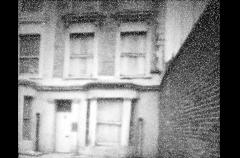For his exhibition at Great Western Studios, John Wild will present an interactive installation that explores the relationships between trauma, memory and architecture within the digital age.
A photograph of 10 Ruston Close, formally 10 Rillington Place, will be both projected within the gallery and simultaneously made accessible online. Each time the image is viewed, either online or within the space, a single pixel will be removed from the image. Over the period of the exhibition the image will decompose directly in response to the number of views it receives.
Pierre Janet wrote that, ‘Certain happenings would leave indelible and distressing memories – memories to which the sufferer was continually returning…’. The Traumatic events, which we so readily identify with the location and architecture of 10 Rillington Place, lead to an attempt by developers to repress the memory through the disappearance of the architecture itself. First by changing the name of the street to Ruston Close, then the eventual demolition of the house and the redesigned of the area to purposely obscure the position and layout of the old road. Thereby preventing a newly built house being readily identifiable as occupying the same plot upon which the old house once stood.
Whilst great length where taken to burry the memory of 10 Rillington Place, the advent of the internet has lead to the emergence of numerous websites where, like Janet’s ‘continual return’, maps, photographs, and testimonials appear like hallucinations which are trawled in an attempt to return, relive, and understand this moment of violent rupture which continues to haunt the digital collective memory.
The installation is influenced by the location of the Gallery directly underneath the Westway. Whilst Rushton Close wasn’t demolished as part of the Westway clearances it will always be associated with the Westway. As JG Ballard wrote, ‘…this was Christie country,’ when discussing his inspiration for Concrete Island, based on an area of land cut of by the Westway. For John Wild the Westway, like the Internet, functions as a circuit of transmission a transient non-place of constant flow that mirrors the data flows which form the materiality of the installation itself.
About the Artist
John Wild is an artist, anarchitect, and psychogeographical explorer of dataspace. He studied sculpture at the Royal College of Art (MA) and received a 1st class BA honors degree from Chelsea College of Art and Design. He received an ARTSADMIN early career artist’s bursary for his live art work, was selected to participate in East End Collaboration 6 where he received mentoring by Franco B. He has participated in numerous exhibitions, festivals and events including Late at the Tate (Tate Britain) and the Sonic Arts Expo.
A dialogue between Art, Society and technology are Central to John's practice. John works with performance, intervention, sonic art, open source Hardware and software, and explores data as a raw material.
The digital decomposition of 10 Ruston Close - An installation by John Wild
Great Western Studios, 65 Alfred Road, London

Ad
Event has ended
This event ended on Tuesday 6th of September 2011
This event ended on Tuesday 6th of September 2011
Admission
Free
Free
Location
Great Western Studios, 65 Alfred Road, London
Tags:
Exhibition
User Reviews
There are no user reviews
